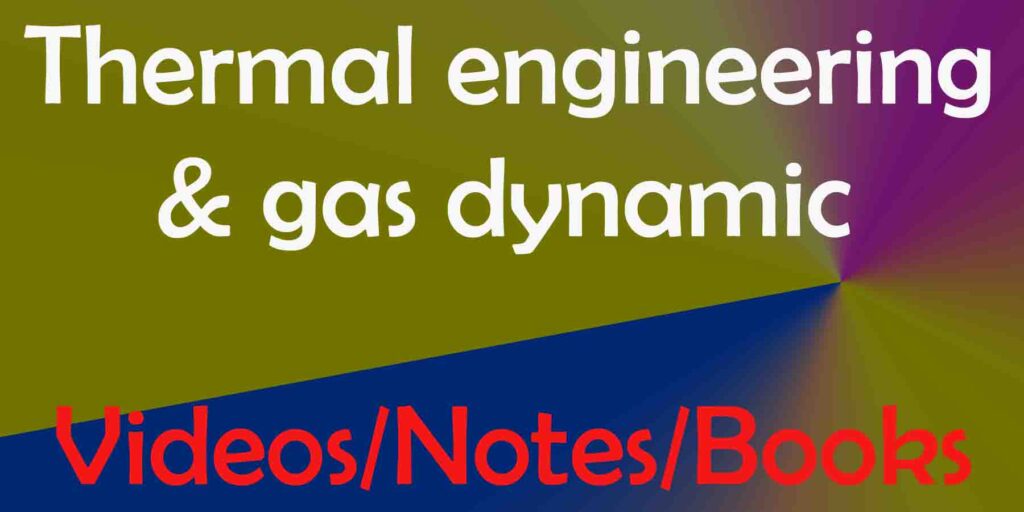Gas dynamic full notes pdf | thermal engineering notes pdf | notes-thermal-engineering-and-gas-dynamics notes | thermal engineering and gas dynamics notes pdf| Mechanical Engineering Notes | Written by Ashish Sir

the branch of hydro aeromechanics that deals with the movement of compressible gaseous and liquid mediums and their interactions with solids. As a part of physics, gas dynamics is related to thermodynamics and acoustics.Thermal Engineering is a specialized sub-discipline of mechanical engineering and chemical engineering that deals with the movement of heat energy and transfer. The energy can be transformed between two mediums or transferred into other forms of energy.
Thermal engineering & gas dynamic notes Syllabus
Unit I Steam generators: classification, conventional boilers, high-pressure boilers-Lamont, Benson, Loeffler and Velox steam generators, performance and rating of boilers, equivalent evaporation, boiler efficiency, heat balance sheet, combustion in boilers, super critical boilers, fuel and ash handling, boiler draught, reviews of boiler codes.
Unit II Phase Change Cycles: Vapor Carnot cycle and its limitation, Rankin cycle, effect of boiler and Condenser pressure and superheat on end moisture and efficiency of ranking cycle, modified Rankin cycle, reheat cycle, perfect regenerative cycle, Ideal and actual regenerative cycle with single and multiple heaters, open and closed type of feed water heaters, regenerative-reheat cycle, supercritical pressure and binary-vapor cycle, work done and efficiency calculations.
Unit III Gas dynamics: speed of sound, in a fluid mach number, mach cone, stagnation properties, onedimensional isentropic flow of ideal gases through variable area duct-mach number variation, area ratio as a function of mach number, mass flow rate and critical pressure ratio, effect of friction, velocity coefficient, coefficient of discharge, diffusers, normal shock.
Unit IV Air compressors: working of reciprocating compressor, work input for single stage compression different, compression processes, effect of clearance, volumetric efficiency real indicator diagram, isentropic & isothermal and mechanical efficiency, multi stage compression, inter – cooling, condition for minimum work done, classification and working of rotary compressors.
Unit V (a) Steam nozzles: the isentropic flow of vapors, flow of steam through nozzles, condition for maximum discharge, effect of friction, super-saturated flow. (b) Steam condensers, cooling towers: introduction, types of condensers, back pressure and its effect on plant performance air leakage and its effect on the performance of condensers, various types of cooling towers.
Thermal engineering & gas dynamic Hand Written Notes
Unit I Steam generators: classification, conventional boilers, high-pressure boilers-Lamont, Benson, Loeffler and Velox steam generators, performance and rating of boilers, equivalent evaporation, boiler efficiency, heat balance sheet, combustion in boilers, super critical boilers, fuel and ash handling, boiler draught, overview of boiler codes.
Unit II Phase Change Cycles: Vapor Carnot cycle and its limitation, Rankin cycle, effect of boiler and Condenser pressure and superheat on end moisture and efficiency of ranking cycle, modified Rankin cycle, reheat cycle, perfect regenerative cycle, Ideal and actual regenerative cycle with single and multiple heaters, open and closed type of feed water heaters, regenerative-reheat cycle, supercritical pressure and binary-vapor cycle, work done and efficiency calculations.
Unit III Gas dynamics: speed of sound, in a fluid mach number, mach cone, stagnation properties, onedimensional isentropic flow of ideal gases through variable area duct-mach number variation, area ratio as a function of mach number, mass flow rate and critical pressure ratio, effect of friction, velocity coefficient, coefficient of discharge, diffusers, normal shock
Unit IV Air compressors: working of reciprocating compressor, work input for single stage compression different, compression processes, effect of clearance, volumetric efficiency real indicator diagram, isentropic & isothermal and mechanical efficiency, multi stage compression, inter – cooling, condition for minimum work done, classification and working of rotary compressors.
Unit V (a) Steam nozzles: the isentropic flow of vapors, flow of steam through nozzles, condition for maximum discharge, effect of friction, super-saturated flow. (b) Steam condensers, cooling towers: introduction, types of condensers, back pressure and its effect on plant performance air leakage and its effect on the performance of condensers, various types of cooling towers.
